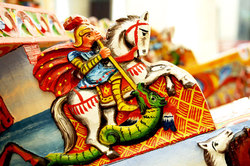 Carved Paladin knight Carved Paladin knight The wheel has been around for at least 6000 years... from Mesopotamia in the Middle East all the way to central Europe. No one really knows when it was "invented". Wheels move people, wood for making fires and the construction of useful items, animals, and products of the harvest. The first wheels were wooden disks... the first spoked wheels came from the Caucasus region down toward Greece and the Mediterranean cultures about 4000 years ago. Of course, the Romans developed their two wheeled chariots... ...perhaps a precursor of the painted Sicilian Carretto, one of the most beautiful of all folk crafted technologies in all of Italy. Their bright primary colors (yellow, blue, red, green) celebrate the sun, the sea, lemons, the glowing lava from Mount Etna, the richness of green olive and grape leaves and the passions in the Sicilian soul. The carts contain remnants of Christianity, paganism, war, passion, nature, opera and mysticism... influences that illustrate the various cultures that have left their mark on Sicily: the Phoenicians, the Greeks, the Romans, The Turks, the Bourbons, Arabs, Normans and Spanish. The battles of Charlemagne and his Paladin Knights remain the most popular theme for decoration. It's a colorful culture, indeed...  Ancient Roman Cart Ancient Roman Cart The French writer Jean Baptiste Gonzalve de Nervo (that's a mouthful) visited Sicily in 1833 and is claimed to be the first to write about decorated Sicilian carts--but that doesn't mean they weren't there long before his arrival in some for or another. He described seeing carts decorated with scenes from many subjects: the story of the New Testament and Jesus, the Virgin Mary, many different saints, the Crusades and Napoleon's conquests. Some insist that after the decline of the Roman Empire the roads in Sicily were left to ruin and fell apart, not allowing small horse, mule or donkey carts to be used on roads between towns and villages--until the "early 1800s" when de Nervo wrote about them and drew attention to them. Just as Columbus "discovered" America--it was always there, with Native Americans before Europeans even knew about it. It's the same with these carts... more than likely, they were in Sicily for many hundreds or even thousands of years. Wherever you go in Italy, it's amazing to see how ancient donkey paths have been lovingly and beautifully maintained over the course of history. They are still used on a daily basis--a necessity, since most of the towns throughout Italy are up on rugged hilltops, with many homes clinging to the side of cliffs. These paths link house to village and vilalge to towns, and are definitely wide enough for donkey carts. Even though Carretto are pulled mostly by horses or large mules nowadays, if you look carefully at the two wooden shafts that the horses are attached to, you will notice in most cases (especially with vintage carts) they are mounted to the horse in an upward angle. This is because the carts were originally designed for use with donkeys--a much shorter animal more suited to the switchbacks common on donkey paths. There might have been gaps in the use of Carretti during history, but they didn't disappeared when the Roman Empire did... they just continued to evolve, as most technologies do. Depictions of ancient Roman carts bear a striking similarity to modern Sicilian carts. As to the history of their being decorated in such a distinctive, colorful style... well, that's something else to investigate... De Nervo told of the cart's horses headbands, dressed up with leather plaques, gilded nails colorful feathered plumes in Sicily's colors... red and yellow. Horses were mostly used in the city and flat plains, while donkeys or mules were more often used in rough terrain for hauling heavy loads. Carts were used for hauling loads such as grain, lemons, wood, vegetables, almonds, grapes, wine, and people--these were called Carretto del Lavoro (work carts). There were also for festive occasions such as weddings and parades called Carretto de Gara. The Carretto was used in the same way the three-wheeled treruote (Ape) gas powered vehicle is used throughout Italy today on farms and in towns as delivery vehicles.  Scale model Carrettino Scale model Carrettino In 1881, the Sicilian Carretto was brought into world acclaim when included as part of a Sicilian folk art display at the Esposizione Nationale in Milan. It became nearly as popular a symbol of Sicilian life as the Trinacria, the three-legged icon that appears on the Sicilian flag. Nearly every visitor to Sicily in the late 1800s were compelled to come away with photographs or postcards of the Caretto. Another way the world became aware of Carretti is when voyagers brought home small models called Carrettino, complete with models of passengers and goods carried on the carts. Even Queen Mary brought one home as a souvenir after a visit in 1925.  Another French writer, Guy de Maupassant, in 1885 described the carts as a “a walking puzzle” because of the abundance of decorative elements. Many wood parts are carved elaborately, some items are applied to the surface of the wood (like carved figures, shells, stone, mirrors or saint figurines), the wheels are painted in wild geometric or floral patterns, animals and tassels are often attached to the hubs. Many types of artisans take part in creating these works of art: coach builders (carrozzieri), wheelwrights (artigiano di ruote), carpenters (carradori), carvers (intagliatori - they use walnut or beech), blacksmiths (maniscalco), leather craftsman (pellettiere) and to finish it off, the decorator (decoratore) and painter (pittore). Fir is used for the cargo trunk area, beech wood for the other parts and ash for the wheels. The blacksmith makes all the metal parts, including the wheel rims and rings to hitch the horses. The pellettiere creates the amazingly decorative harnesses with feathers, colorful wool, silk bows and fringes, mirrors, ribbons, and metal studs. With all these artisans and varied skills, it would typically take three months to complete a cart. Cart accessories often include a hanging rope net mounted just under the cart to hold food, wine, water and feed bucket for the animal. A chain for a dog, a basket, a lamp hanging on the front side (a sort of headlight), and an umbrella for protection from sun or rain complete the outfitting of the cart.  The Sicilian cart is no longer used today for carting heavy loads but has gained a proud place in the folklore and history of Sicily. The carts are used for festivals, religious events and other special occasions. A well known festa is in S. Alfio, in Trecastagni, Catania in which carts leave from Catania and other areas at night and arrive in the morning to assemble in the village square. In different areas of the island it is possible to distinguish between four basic types of cart: palermitano (Palermo), castelvetranese (Castelvetrano), trapanese (Trapani), and catanese (province of Catania). Two museums are dedicated to preserving the memory of the Sicilian cart tradition exist: The Museo del Carretto Siciliano in Terrasini, in the province of Palermo, and The Museo Gullatti in Bronte, in the province of Catania. Nowadays the carts can be admired in museums and during folklore events. In Sicily nowadays, the colorful tradition of the Carretto is carried on (pun intended) by painting small, motorized vehicles called Treroute (literally, three-wheeler) or Ape (pronounced AH-pay... a brand name). In Sicily, these three-wheeled work vehicles are called lapa. You will also find Vespa scooters and Fiat 500s painted in the glorious carreto style. There is one more custom associated with the Sicilian Carretto that needs to be mentioned... Canto di Carretto.... the Carretto song tradition of cart drivers. Carrettiera (cart drivers) cup their hands behind their ears and sing chants similar in sound to those coming from the towers of Mosques--perhaps an influence of the merging with the Arab culture long ago. They challenge other drivers in this way to do better in their own songs. They sing without any instrumental accompaniment of love, war or hard times. This is truly Sicilian blues. The Festa di San Giuseppe in Bagheria in early August is one place where you can not only see many fine examples of Carretti, but also hear the songs of the carrettiera during a singing competition. Check out the videos below to hear the songs and see Carretti hitched and in motion...
The history of the Sicilian Carretto is a compelling one and worth searching out when voyaging to Sicily for the first time...
--Jerry Finzi If you enjoyed this article, please SHARE it and LIKE it on your favorite social media site. Ciao! We also have pages on: Google+ StumbleUpon
0 Comments
Your comment will be posted after it is approved.
Leave a Reply. |
Categories
All
Archive
June 2024
|



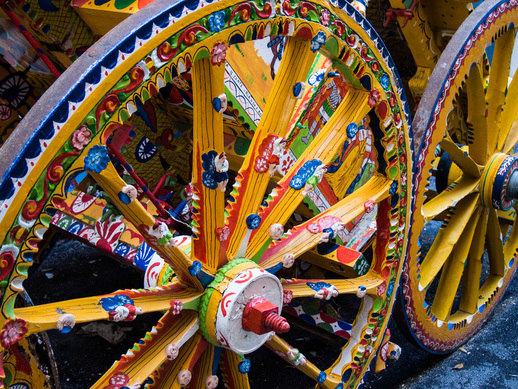



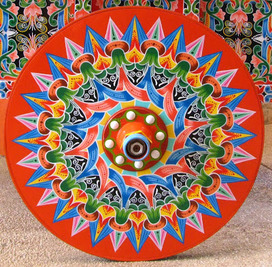








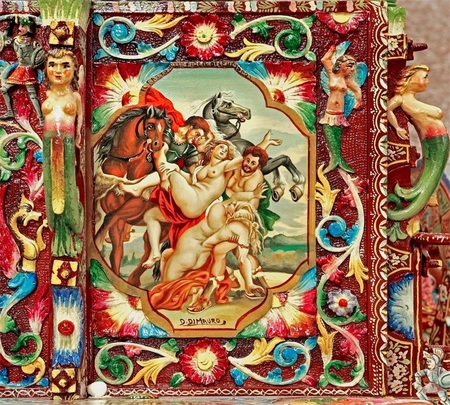
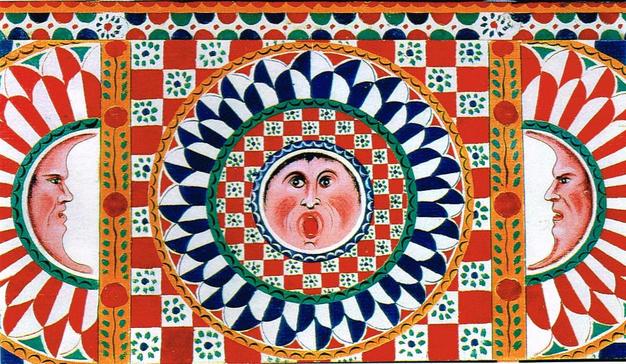








 RSS Feed
RSS Feed
